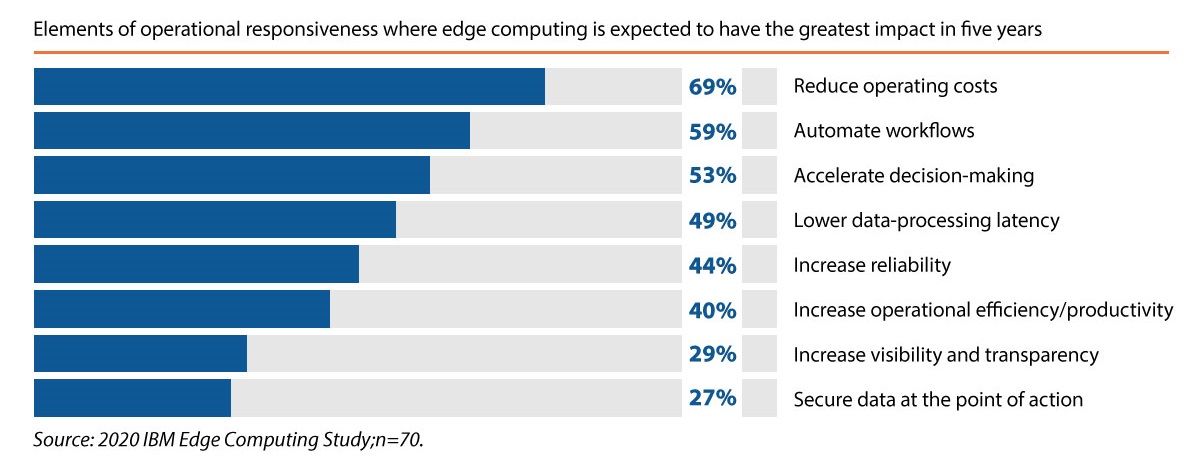Smartphones have been reinventing communications and data networks, and the telecom sector has been battling to stay up with the latest technologies to provide the level of speed and connectivity that customers want with the launch of each new device. For years, tech experts have predicted the actual advent of the Internet of Things (IoT) and the number of mobile IoT connections is projected to grow to 3.5 billion in 2030.
For seamless deployment of data-heavy applications containing Augmented Reality (AR), Artificial Intelligence (AI), and streaming video, storage devices, and computational operations must not be far from the connected devices. These ambitious concepts, like smart cities, can only achieve their fullest potential if IoT is empowered with real-time data sequencing.
As per a survey by IBM, 94% of communication service providers anticipate that edge computing will have a favorable impact on operational responsiveness in five years, followed by lower operating expenses, automated workflows, faster decision-making, and reduced latency in the data processing.
Edge computing helps to minimize latency and can enable telecom businesses to lessen their reliance on the cloud. It also allows them to shift to a modernized architecture by allowing them to collect and analyze crucial data locally via an edge server.
Edge Computing is Empowering Telecom Industry to become Future-Ready
Edge computing is increasingly becoming a must-have for telecom businesses aiming to be future-ready. It makes the IoT deployments easier and enables telecom industry to:
Implement IoT Devices
The key to enhanced networks and processes is the seamless implementation of IoT devices. Edge computing enables the processing of large volumes of data generated by these devices quicker and more efficiently and allows them to be fully operational.
5G Adoption
5G connection is an important edge computing component. It provides a high-speed low latency network for smooth communication with IoT sensors across devices. According to Ericsson, about 25% of 5G use cases are projected to rely upon edge computing by 2023.
Edge Over Competition
The telecom industry is a highly challenging, developed market with new competitors entering daily. Deploying the correct technological breakthrough at the right moment can be a key difference for telecom businesses looking to achieve a competitive advantage.
Prevent Fraud with Real-time Revenue Assurance
The existing framework for telecom fraud prevention and revenue loss is based on outdated technology and processes that may not be as effective as they should be. For maximizing fraud prevention and to mitigate the risk of revenue losses, telecom regulators must adopt modern technologies and innovations like real-time revenue assurance.
The meaning of real-time is the capacity to make intelligent decisions on data inconsistency within milliseconds. Edge computing has a role here, as it can reduce latency by processing data at the point of decision and avoiding unnecessary round trips. This speed acquired through edge allows real-time revenue assurance and prevent fraud and revenue losses for telecom businesses.
Panamax's Revenue Assurance solution is a process in which revenue leaks are detected, monitored, and prevented. It is a method to enhance data quality and processes that increases profit, revenue, and cash flows, without affecting demand. Our solution helps to avoid revenue losses arising due to defective billing systems, inefficient services, and fraud.
The Roadmap for Shifting to Edge
Telecom players need serious consideration of their digital strategy for the upcoming years and an integrated roadmap incorporating the below mentioned areas to ensure a smooth and successful transfer towards edge computing.
Data Centers
Edge data centers have demonstrated that they are a suitable solution for mobile edge computing frameworks, which require fast and effective management of data. However, the choice as to where to create new data centers, particularly given the large capital cost involved, is always a little challenging for edge computing organizations.
Several telecom service providers have adopted the new technique for establishing ‘micro’ data centers at the base of their mobile towers. As a majority of data via their networks are already transferred using cell towers, on-site storage, and processing capacity has proved to be a realistic, cost-effective solution, which also enables mitigate the prevalent problem of ‘last mile connectivity’.
Augmented Reality (AR)
The installation of AR is one of the most interesting cases of mobile edge computing. AR systems, powered by smartphones, have the potential to interface with local IoT edge devices to deliver a better overview of their environment for the user.
By giving real-time access to remote experts, AR can enhance the accuracy of telecom equipment inspections. It can reduce the amount of time and money spent on telecom hardware inspection while also ensuring its continuous and reliable functioning.
Secured Gateways
Mobile edge computing has considerably increased the number of potential access points across the networks, and telecom companies are increasingly considering methods to provide greater security for consumer data.
Since not every IoT edge device has the ability to deploy effective security software, a large proportion of the security responsibility is transferred to the next nearest processing device. Edge computing providers can efficiently create a firewall between IoT edge devices and cloud infrastructure by implementing secure gateways on these devices. The risk of a hacked IoT edge device is considerably reduced with these security procedures.
The Impending Transition to Edge Computing:
The telecommunications industry is at the forefront to initiate the shift to the edge. In an extremely contested market, telecom businesses must use state-of-the-art technological innovation and services to support and enhance growth. The telecom companies need to strongly engage in active discussions with the technology services provider and expert consultant to advance towards edge computing as they chase a brighter future ahead.
Related Blogs
6 Tips for Telecom Companies to Excel the Mobile Money Market
Why is Digital KYC Essential in Telecom Industry?



















